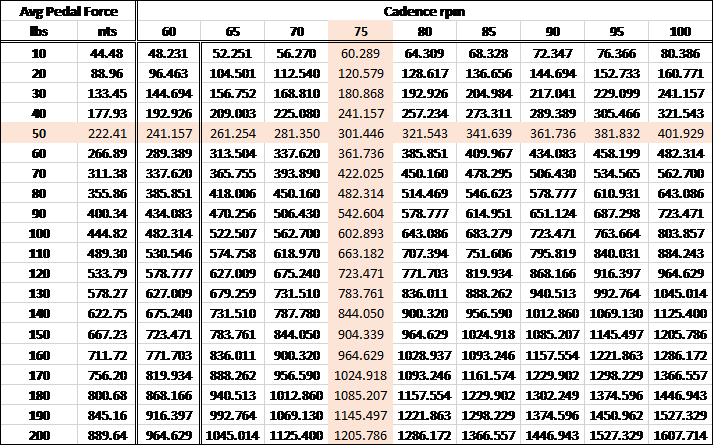Pedaling Power Output
We are now in a position to discuss how Pedaling Power is produced. Notice that we are for the moment focused on pedaling and not what shows up at the rear wheel. We cannot discuss that without including the process that takes pedaling power and converts it into forward power.
Pedaling Work Computation
Work is the effort needed to accomplish a physical task. It is computed as force times distance. So how much work does it take to pedal one cycle for a standard crank length? We know the pedaling circle is 3.67 ft, so all we need to do is multiplied this times the average pedal force. For practical reasons, we want to express the final result in Joules.
Wped (Joules) = PedFor(Nwts) ⋅ Cadence(rpm) ⋅PedCircle (Mts)
Consider a Pedal Force of 10 lbs or 44.48 nwts. The work done over one cycle is:
Work = 10 lbs x 3.67 feet = 36.7 ft⋅lbs = 50.97 Joules
Pedaling Power Computation
Work is the total effort without regard to how quickly that work gets accomplished. Once we add time into any cycling discussions, we are asking whether a cyclist can produce those joules in a given time interval. We therefore determine the power by dividing the work by the interval the work is to be performed.
Pped (Joules) = Pedal(Nwts) ⋅ Cad(rpm) ⋅PedCircle (Mts)/60 secs
The work computed above was for one cycle. If we want to compute the power, we simply multiply by the cadence. So if we are riding at 80 rpm, the cyclist needs to be producing a power level of:
P = 50.97 joules⋅80 rpm = 4077.6 watts
You may notice that in general for circular motion, the cadence plays the role of velocity in power calculations where
P = F⋅V
Pedaling Power from Avg Pedal Force and Cadence
We can compute a table that tells us how much pedaling power we would generate based on an average pedal force at a specific cadence. This answers provides the relationship between Pedaling Power and Pedal Force at a given cadence we raised earlier.

The colored row and column provide two ways to change power:
- Constant Cadence/Increasing Pedal Force – This is as expected. Your power output increases as you increase your pedal force while leaving your cadence fixed.
- Constant Pedal Force/Increasing Cadence – As you increase your cadence but keep the same amount of pedal force, you increase your power output.
What are realistic cycling numbers?
The following are power estimates from a 2012 blog on SensibleCycling Pedal Force. The assumptions were a a 172.5mm Cranks, a cadence of 85 and a 70kg rider (165 lbs) .
A Grade Rider
Time Trial – 348 Watts
Pushing Hard (5min) – 416 Watts
Full Bore Sprint – 1378 Watts
E Grade Rider
Time Trial – 193 Watt
Pushing Hard (5min) – 235 Watts
Full Bore Sprint – 902 Watts
A couple of the high numbers would need the equation to compute. However, looking at an A Grade Rider Time Trial with 348 Watts at a cadence of 85, they would be generating a pedal force of 228 Newtons or approximately 50 lbs.
Next Topic: Gearing
